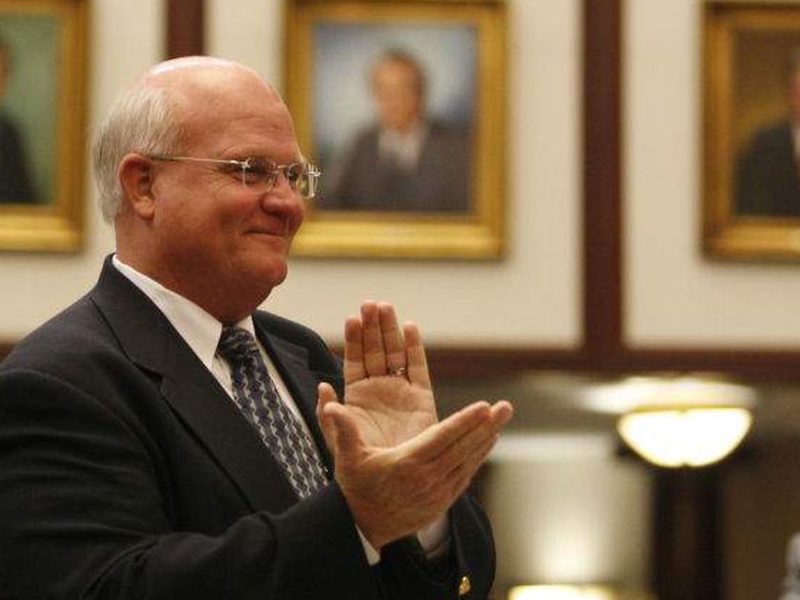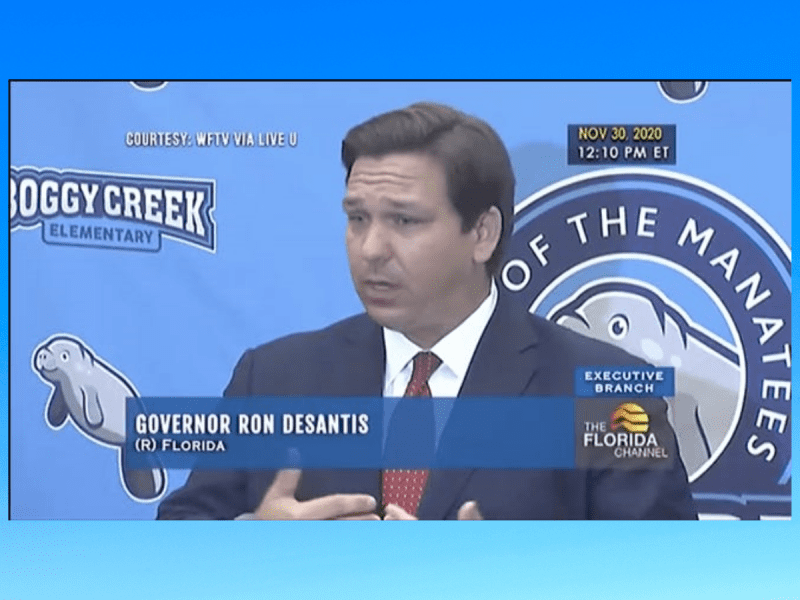Why Reopening Schools Has Become the Most Fraught Debate of the Pandemic
The American Prospect | by Rachel M. Cohen | October 28, 2020
Many families are desperate to get their kids back to school, and many political leaders agree, worried about harm to children’s educations and believing that key to fixing the economy is making it easier for parents to work. But the pandemic, which is still raging and getting worse nationwide, has made many of these school plans more challenging, if not elusive. It’s also led to one of the most politicized and divisive debates in America: Can we safely reopen schools?
The go-to academic on this question has become Emily Oster, a prominent economist at Brown University. Oster doesn’t have a background in public health, but over the last decade she has earned a reputation as a data-driven, empathetic, and trusted parenting expert, writing best-selling books on pregnancy and child-rearing. Her email newsletter, ParentData, is one of the most highly subscribed publications on Substack. Since March, she’s been helping families navigate questions around school reopenings, giving numerous interviews on what the available research suggests, and writing op-eds for outlets like The New York Times, The Washington Post, The Atlantic, and Slate.
Oster tells her audiences that she’s using data to help inform the best decisions possible, though at times she’s adopted more explicit advocacy on the need to reopen schools. Occasionally, she has downplayed negative research findings that complicate the picture, and amplified studies that experts say were weak.
Back in early May, for example, Oster concluded that “infection among kids is simply very unlikely. It’s not that they are infected and don’t know it, it seems like they are just not infected very often.” But this ignored some conspicuous caveats to those early studies—for example, kids were rarely tested in the spring (as tests were in short supply), and children were stuck at home, with far less opportunity for exposure.
In late July, when a study came out that suggested children with COVID-19 have a higher viral load than adults, Oster quickly wrote a piece saying it would be a “very big leap” to apply these findings to school reopening discussions. Instead, she urged focus on a large South Korea contact tracing study, which suggested younger children transmitted the virus in their households at a lower rate than other groups. A month later, the leaders for that South Korea study said it wasn’t really clear who infected whom in the households, and called for further research. Even today, how effectively children transmit the virus to others remains one of the fuzziest, and most pressing, questions.
Parents and writers (many of whom are parents) have embraced Oster’s thinking, along with some oft-quoted public-health experts like Ashish Jha, also of Brown, and Jennifer Nuzzo of Johns Hopkins, who say we can move forward more quickly with reopenings, especially at the elementary school level. But a growing number of epidemiologists—generally ignored by the media—have been urging caution, stressing that our understanding of child transmission remains far more limited than some of the louder voices in the conversation have suggested.
These debates over the science have grown more charged, as leaders seek to bring more students back to the classroom, but as Congress continues to drag its feet on stimulus funding. Many cash-strapped districts are struggling to implement the kinds of mitigation strategies that experts say have worked well abroad and that more-affluent schools have adopted. As COVID-19 cases rise nationwide, the question remains if reopening schools is a tolerable risk or a dangerous gamble, especially for communities of color ravaged most hard by the virus.
IN LATE AUGUST, Oster announced a new project of “systematic data collection and reporting” on COVID-19 in schools, in partnership with associations of school superintendents and principals. “Once we have a dashboard for these data, the media could use these sources to drive their coverage,” she wrote. “Even if they chose not to—because ‘Day 45 with infection rate below 0.01 percent’ doesn’t generate a lot of clicks—citizens would be empowered to analyze the relevant information themselves.”
With a public desperate to return to normalcy and school reopening at the forefront of that, it didn’t take long for national outlets to start reporting Oster’s data. On September 23, The Washington Post ran a story boldly headlined “Feared Coronavirus Outbreaks in Schools Yet to Arrive, Early Data Shows.” Featuring figures from Oster’s new tracker, the Post reported that, for a two-week period beginning August 31, 0.23 percent of students in her database had a confirmed or suspected case of COVID-19, and just 0.49 percent of teachers. About two weeks later, Oster published an op-ed in Insider with the provocative headline “School Infection Rates Are Low Even in Areas With High COVID-19 Rates, According to Data on 550,000 US Students.”
A growing number of epidemiologists have been urging caution, stressing that our understanding of child transmission remains limited.
These stories clearly suggested that COVID-19 infections in schools were few and far between. But they also reflected an extremely small and unrepresentative sample of schools. There are over 50 million K-12 students in 130,000 public and private schools across the United States, but the database used in the Post story had just 550 public and private schools nationwide voluntarily reporting data, including at least 200 schools that were fully remote. And of the 550,000 students in the Insider article, less than a third (about 175,000) were learning in person.
Oster acknowledged that more data would be needed to understand what was going on in areas with high transmission, but she made no mention that students are still getting tested at significantly lower levels than adults, and that many schools have no requirement for even symptomatic students to be tested.
Nevertheless, her findings were soon echoed by influential media figures, like MSNBC host Chris Hayes, who tweeted out to his 2.2 million followers, “We now have pretty good data” to show that schools can open in person even in places “with pretty high community transmission.” The authoritative assurances brought relief to tired families, but when some public-health experts offered objections and reason for skepticism, the media establishment either ignored them or cast them as liberal hysterics. In fact, anyone who objected must be unreasonably searching for a world where zero risk exists. This is a straw man, of course, but an effective one—and one easily found in many articles about school reopenings, including Oster’s pieces.
Here are some additional facts about the COVID-19 School Response Dashboard dataset, as it existed on October 25. There were 1,322 schools voluntarily reporting data, or about 1 percent of all K-12 schools in the country. It did not say how many school districts were reporting, though Oster told me last week they currently have “about 150.” There are 13,500 school districts across the United States.
A more detailed look brought its glaring gaps into sharper relief. There was not a single urban traditional public school reporting data across 27 states in her dataset, including from Florida, Texas, New York, Minnesota, Arkansas, and Mississippi. Some states, like Colorado, Kansas, Ohio, and Alabama, had just one urban traditional public school reporting data. Oster told me they’re working to make their dataset “more representative” and conceded that those who opted to voluntarily report tended to be a “higher-income sample, and more suburban.”
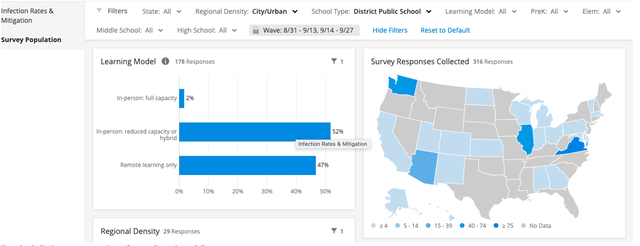
SCREENSHOT
An examination of suburban traditional public schools, though, was not much better. Twenty states in her tracker had zero traditional public schools reporting; Nevada and South Carolina had one; Texas and North Dakota had two; Connecticut and Oklahoma had four.
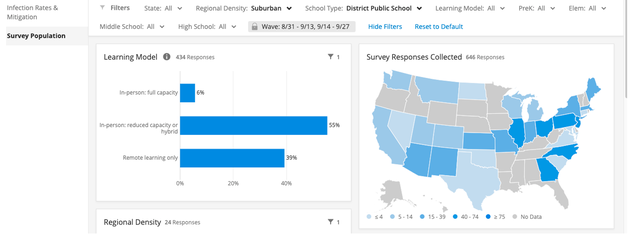
SCREENSHOT
The resulting concentration of private schools, coupled with the dearth of public schools, makes it especially difficult to draw inferences, especially for less-resourced areas and communities with high concentrations of Black and brown students. This work-in-progress dataset wouldn’t be such a concern if Oster wasn’t disseminating broad conclusions based upon it. In a Wall Street Journal article published last week on school reopenings, Oster told the reporter that her data “suggests the risks to kids from going to school are small.”
Rebekah Jones, a former Florida Department of Health data scientist who says she was fired in May over a refusal to manipulate her state’s COVID-19 stats, has publicly pushed back on Oster’s claims. Over the summer, Jones launched her own national tracker of school coronavirus cases called COVID Monitor. It’s run in partnership with Google and FinMango, a financial-literacy nonprofit. To date, it has data from nearly 4,000 school districts, over 26 times the number in Oster’s dataset.
Oster approached Jones’s team in August about potentially collaborating, and they offered Oster full and free access to their data. “But she basically decided to just pick what data she wanted, not what’s available,” says Jones. “It’s offensive to researchers, when you see something so unabashedly unscientific, and when the opportunity to do something scientific was there.” Jones added, “You can’t just have one point in a state and claim you have a grasp on what is occurring for a wide spectrum of school types and incomes, but that is literally what she does.”
Oster says she thinks Jones’s tracker is a “great project,” and it’s “really valuable to have such a comprehensive view,” but that her goal was to also study individual school rates. COVID Monitor, however, does track school rate data.
THINGS CAME TO A HEAD following a viral Atlantic piece Oster published earlier this month, with the controversial headline “Schools Aren’t Super-Spreaders.” Her argument, that schools are minor sources of transmission, hinged primarily on her own dataset, though she also pointed to reopenings in places like Florida, Georgia, and Texas. There were no caveats about why those states’ data might be interpreted with caution, and no mention of their rising caseloads.
Instead, Oster employed the straw man. “These numbers are not zero, which for some people means the numbers are not good enough,” she wrote. “But zero was never a realistic expectation.”
While surveys of parents have shown reticence to schools reopening, especially among parents of color, Oster chalked up slower reopenings to “fear and bad press.” She dinged Chicago, Los Angeles, and Houston for remaining remote, despite having relatively low positivity rates, and bluntly concluded, “Predictions about school openings hurting the broader community seem to have been overblown as well.”
Her piece said nothing about low in-person attendance rates for districts that have reopened, the lag time in reporting, and the persistent inadequacy in testing and tracing school-related cases. It also didn’t mention the major public-health fear that transmission could change as the weather gets colder. It made no mention of the fact that children now make up 10 percent of all COVID-19 cases in the U.S., up from 2 percent in April.
Oster’s story also said nothing about race. “It’s myopic. The piece of analysis that’s missing both in her Atlantic article and the dashboard is that Black and brown communities have been disproportionately hit hard by COVID,” said Constance Lindsay, an education policy researcher at UNC. Black and Latino communities have been contracting COVID and dying of it at higher rates, and while Oster targets Chicago, Los Angeles, and Houston specifically for not reopening schools, there was no mention that these cities have higher concentrations of Black and Latino families. Another study published in mid-September also estimated that up to 44 million high-risk adults in the U.S. either work in schools, or have school-aged children. “You can have a low overall positivity rate and it still be a place where you don’t want to open schools because it will further the health disparities and minority children will be at greater risk,” says Theresa Chapple, an applied epidemiologist who focuses on child and maternal health.
Lindsay adds that she’d feel a little better if Oster’s database broke out information about Title I schools and the percentage of Black and brown students at each school. Oster told me “that’s something we can certainly do, and I think those kinds of covariates are on our to-do list.”
A number of epidemiologists started speaking out following Oster’s Atlantic article, concerned about the way she had used her preliminary data with strong selection bias to draw sweeping conclusions about risk.
“Places where you have people sitting, talking, and stationary, where those three things overlap, that’s where you run into potential for superspreading clusters, and schools hit all those things,” says Dominique Heinke, an epidemiologist who critiqued Oster’s piece. “For the most part, we just don’t have good data on kids and spread. It doesn’t mean kids will spread it; it means we don’t have the research right now to say either way.”
The general premise of Oster’s piece, of whether schools are “superspreaders,” also reflected how the goalposts around school reopening debates have shifted throughout the last few months. “A place is not a superspreader, a superspreader has to do with k, it has to do with the conditions that make a virus more likely to spread,” Chapple says.
We had no study showing the White House “was a superspreader” for eight months of the pandemic. Yet when the White House had a superspreading event, few were surprised, given the conditions that were tolerated there. Wedding ceremonies can be superspreaders, and they can also be small, held outdoors, and safe. Indoor dining can lead to superspreading clusters, though limiting customers and taking other precautions can reduce that probability. Japanese officials have chalked up conditions that increase the likelihood of superspreading events to the “three C’s—close contact, closed spaces, and crowded places.
Chapple thinks many leading the conversation have lost sight of the goal, which is to reduce the rate of the coronavirus in the community. “If opening schools is adding to community transmission, then we’re fighting a harder battle, even if we raise transmission by a tenth of a point,” she says. “People don’t want to come out and say they’re OK with others dying, so instead they just cite a small percentage number and avoid talking about what that actually translates to for people, families, and communities.”
The conventional wisdom has also not caught up to rising caseloads and a long-expected fall wave. Over the last two weeks, there’s been a 43 percent increase in COVID-19 cases across Texas. Cases among students and staff have risen to over 21,000, even as most districts do not require students to be tested, and the state only reports test-confirmed cases. Nevertheless, last week The Texas Tribune reported that some districts say they will no longer accommodate educators at high risk from infection by allowing them to work remotely.
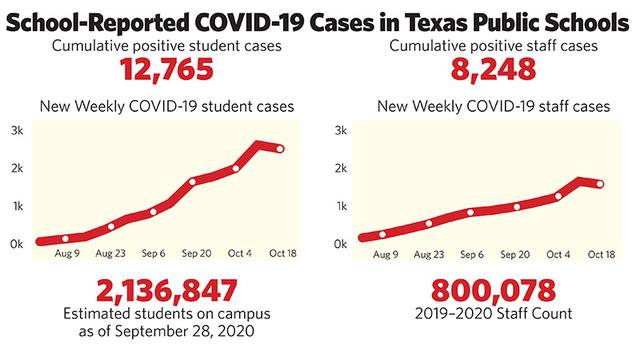
SOURCE: TEXAS DEPARTMENT OF STATE HEALTH SERVICES
Meanwhile, Florida is on the verge of a COVID-19 resurgence, with modelers warning that Miami-Dade and Broward Counties are particularly at risk for case increases. Jones’s tracker has reported over 11,000 school-age cases, from more than 7,000 Florida schools, since September 8. Two of the state’s largest school districts—Broward and Miami-Dade—didn’t even open up for in-person learning until this month.
The CDC estimates that 40 percent of all COVID-19 cases are asymptomatic, and younger students are less likely to show symptoms than older ones. “While there are numbers of students being reported as positive, it is unclear how well those counts are capturing the true spread of COVID on a campus,” Dan Potter, the associate director of Houston Education Research Consortium, told me last week over email. Potter puts the blame on his state and federal government for failing to provide districts with the resources to proactively measure and monitor COVID-19 spread. In the absence of that support, he said, districts have to rely on parents and staff to voluntarily self-report test results.
PUBLIC-HEALTH GROUPS that initially made firmer declarations about the safety of kids and coronavirus have since tamped down their statements. One of the most prominent is the American Academy of Pediatrics, which made waves in late June when it issued strongly worded guidance urging schools to open for in-person learning, and stating that “the preponderance of evidence indicates that children … may be less likely to become infected and … to spread infection.” In August, the association updated its guidance to say more research is needed to understand infectivity and transmissibility in children, and that opening schools to all students is “likely not feasible” in many places because of community spread.
“I think the stance the AAP took in the beginning was that since negative health outcomes to children seem low with coronavirus, and the risks of not being in school are high, therefore children should be back, but that’s a very child-centered stance and children are not the only ones at school,” says Chapple. “We do not know the impact that infected children can have on our vulnerable populations. The conversation can’t just be about children, it has to be about children and communities.”
One hurdle is the poverty of strong data. The first U.S. child death related to COVID-19 didn’t happen until May, a few months into the pandemic and after thousands of seniors had already died. This helped deprioritize research into specific areas involving children: transmissibility, the long-term effects of infection, and the need for testing.
In late August, Laura Garabedian, a professor of population medicine at Harvard Medical School, and Rebecca Haffajee, a health policy researcher at RAND, co-authored an op-ed in USA Today on the limitations of existing studies that had suggested children could transmit less COVID-19 than adults. Both are parents in the Boston suburbs, and after attending Zoom meetings to learn about their schools’ plans for reopening, they realized quickly that leaders were making decisions based on shaky research. “Right now, the evidence on children’s rates of infection and transmission is inconclusive,” they wrote, and urged “aggressive” mitigation strategies until more is known.
By September, the CDC had published a new study again complicating our understanding of transmission, finding that children who likely got infected in Utah child care centers spread the virus to others outside, including to adult household members. The centers had varying mask policies.
“What was really interesting about that study is that in each of those three [child care] facilities, they think the first case was from a staff member,” says Garabedian. “So it was an adult suspected of bringing it in, they spread it from staff to children, and then the next step was children brought it home. That was a really important study and I haven’t really seen anything similar to that.”
Evidence from other countries, though regularly cited as conclusive proof of the safety of reopenings, presents a mixed picture, and often comes with methodological limitations. Studies from Australia and Ireland suggest that schools with positive cases can control and prevent transmission if proper mitigation strategies are in place. A recent study from Spain found school reopenings were not linked to spikes in community rates, and in Germany, school reopenings were actually linked with lower rates of COVID-19 spread.
But European school outbreaks are occurring, particularly in places where community transmission is on the rise. Another study published in Science in late September used extensive contact tracing in India and found, among other things, more evidence of child transmission, including from young children to other young children. And last week, Israel’s health ministry released a report finding that Israeli children were more likely to be infected with COVID-19 than adults. The ministry warned that children can act as “super-spreaders” and noted that 51 percent to 70 percent of infected children were asymptomatic. A group of nine Israeli epidemiologists, though, rejected that report, arguing the government had misinterpreted its data.
Garabedian and Haffajee cite Australia and Ireland as encouraging examples in their USA Today piece, but caution about extrapolating too much from their experience, and noted some of the international research was also conducted when kids were spending more time outside.
In a joint interview, Garabedian and Haffajee said that in places where schools quickly test, contact-trace, and impose measures like mask-wearing, upgraded ventilation, and social distancing, reopenings seem to be working. But they acknowledged that not all communities have the resources to put those mitigation strategies in place, and they wonder what will happen in places where community rates rise, and contact tracing becomes overwhelmed. The researchers said we also have no clear idea of what would result if schools were again doing in-person learning at full capacity, which is happening in few places in the U.S.
THE FACT THAT scientists say we’re still trying to get a handle on kids and transmission hasn’t stopped many prominent writers and media outlets from declaring questions resolved, and the data decisive.
In a Wall Street Journal op-ed published last week entitled “End the School Shutdown,” a research fellow with the conservative Hoover Institution and an economics professor at the Naval Postgraduate School cited Oster’s tracker showing September case rates of .13 percent among students and .24 percent among staff. “That’s a shockingly and wonderfully low number,” they wrote, while providing no context.
New York Times education reporter Eliza Shapiro went so far as to tweet last week, “It seems increasingly like the choice to keep elementary schools closed in places where the virus is contained and there are school safety measures in place is no longer grounded in science.” Her tweet linked to a New York Times story where the third paragraph said, “The evidence is far from conclusive, and much of the research has been tarnished by flaws in data collection and analysis.” Shapiro’s post was amplified by Oster and FiveThirtyEight’s Nate Silver, though just two days after the aforementioned article came out, updated random sampling from the U.K. showed that children there were actually more prone to infection than adults, echoing the findings from Israel.
Perhaps most influentially, in a widely read ProPublica piece from late September on students left behind by remote learning, journalist Alec MacGillis theorized that anti-Trump sentiment was a significant factor in why schools were not reopening faster in Democratic-run cities. (The argument, that liberals turned against school reopenings because the president started speaking more forcefully for them, was silent on Republican support also dropping in that same time period.)
MacGillis’s feature made the case that more schools could safely reopen, and even referenced the September Washington Post story on Oster’s tracker, noting that “so far there was little evidence of the virus spreading inside school buildings.” He omitted the CDC research on toddlers infecting their household members, and he downplayed news that cases were rising among children.
MacGillis’s main points were that in many places the cure appears worse than the disease; that we’re underestimating the long-term harms to students’ academic, social, and physical development; and that these policy choices threaten to widen already gross disparities between the rich and poor. There is absolutely truth to this, and research has long shown that in-person instruction is better for children. The nation’s inequitable access to broadband internet has made virtual learning even harder for millions of families to access, and the fact that bars and restaurants remain open for indoor dining while schools are closed is a staggering political choice.
Still, many adults work in schools, and illness and death can set back kids, too. If children infect their parents, teachers, or neighbors, or spend time in school anxious that they might, experts warn that too could yield harm. (Some students agree, and have rallied in solidarity with teachers against reopening plans.)
New research is still emerging almost every week, like a study from Sweden that found schools played an overall minor role in the spread of COVID-19, but that teachers in schools with older students had double the rate of infections compared to those who taught remotely, and their partners also had higher rates.
Jones, of COVID Monitor, told me she submitted a study two weeks ago to the CDC on trends in K-12 Florida school reopenings, but that the projected wait time for review is five weeks.
Some businesses—like Google and The New York Times—have recently announced they will continue to allow remote work until July 2021, and some teachers believe they should be allowed to do the same, especially if states and the federal government continue to deny resources to schools to help them implement robust mitigation strategies. Other districts are considering returning to in-person learning just for elementary-aged children, or those who are homeless or have special needs. In Washington, D.C., the mayor wants to allow 21,000 elementary school students to return beginning November 9, although 14,000 of those students would do virtual learning from inside classrooms, supervised by non-teachers.
Moving forward, Chapple suggested researchers like Oster partner more with local health departments to gather better surveillance data on children. Whitney Robinson, an epidemiologist at the University of North Carolina, also noted the federal government has given no additional funding to the National Institute of Child Health and Human Development, a decision, she says, that reflects the government’s deprioritization of young people.
“People are resilient, children are resilient, families are resilient, but over and over we see tragedies that if you’re not getting what you need at critical points in development it can have really long-term consequences,” Robinson says. “So I think about the short-term and long-term risks. Still I can say something is pretty safe, but people need to feel safe.”
Oster, unlike others and to her credit, does acknowledge that some people will get sick and even die if schools reopen. In addition to emphasizing the social, emotional, and academic harms students face by missing in-person school, Oster says we accept mortality risks in normal times, like allowing people to drive cars, have swimming pools, and avoid the flu shot. “There will be some in-school transmission, no matter how careful we are,” she wrote in July. “This is the unfortunate reality. Some of these people may get very sick. If we are not willing to accept this, we cannot open schools.”




